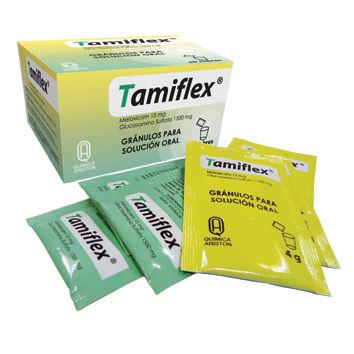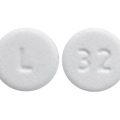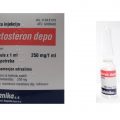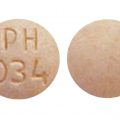What is Tamiflex?
Tamiflex is a combination medication used in the symptomatic treatment of osteoarthritis and other articular and extra-articular rheumatic diseases. Each pack of Tamiflex granules for oral solution contains meloxicam 15mg and glucosamine sulfate 1500mg. Meloxicam is a nonsteroidal anti-inflammatory drug (NSAID). It works by reducing hormones that cause inflammation and pain in the body. It may help reduce swelling by lowering levels of prostaglandin, a hormone-like substance that usually causes inflammation.
Although glucosamine is naturally occurring in the body, factors such as advancing age, physical trauma, and medical complications can negatively impact the ability of the body to synthesize this compound. As glucosamine is not found in the diet in significant amounts, supplements containing it like Tamiflex have become extremely popular. Glucosamine sulfate is a widely used supplement to help ease pain in people with osteoarthritis. Osteoarthritis happens when cartilage breaks down. This can cause joint pain. Glucosamine is used by the body to make other chemicals that build tendons, ligaments, cartilage, and the fluid that surrounds joints. Joints are cushioned by the fluid and cartilage around them. Taking glucosamine might increase the cartilage and fluid around joints and or help prevent their breakdown.
In combination, the chondroprotective and repairing effect of glucosamine, combined with the analgesic and anti-inflammatory action of meloxicam in Tamiflex, significantly alleviates pain at rest and movement, improving mobility in the short and medium term.
How to use Tamiflex
Pour the contents of Tamiflex one sachet into a glass of water shake and drink once a day, preferably with breakfast. Take Tamiflex exactly as prescribed by your doctor. Follow all directions on your Tamiflex prescription label. Your doctor may occasionally change your dose to make sure you get the best results. Do not take this medicine in larger amounts or for longer than recommended. Use the lowest dose that is effective in treating your condition.
Tamiflex side effects
Tamiflex can cause mild or serious side effects. The following list contains some of the key side effects that may occur while taking Tamiflex. This list does not include all possible side effects. The more common side effects that can occur with Tamiflex include:
- abdominal pain
- constipation
- diarrhea
- dizziness
- headache
- indigestion or heartburn
- itching or rash
- nausea
- heartburn
If these effects are mild, they may go away within a few days or a couple of weeks. If they’re more severe or don’t go away, talk to your doctor or pharmacist.
Serious side effects
Call your doctor right away if you have serious side effects. Call 911 if your symptoms feel life-threatening or if you think you’re having a medical emergency. Serious side effects and their symptoms can include the following:
- Heart attack. Symptoms can include:
o chest pain or discomfort
o cold sweat
o pain or discomfort in one or both arms, your back, shoulders, neck, jaw, or area above your belly button
o trouble breathing
- Stroke. Symptoms can include:
o dizziness
o numbness or weakness of your face, arm, or leg on one side of your body
o severe headache with no other cause
o sudden confusion
o trouble speaking or understanding speech
o trouble walking or loss of balance or coordination
o vision problems in one or both eyes
- Stomach and intestinal problems, such as bleeding, ulcers, or tearing. Symptoms can include:
o black, sticky stools
o bloody stools
o severe stomach pain
o vomiting blood
- Liver damage. Symptoms can include:
o dark urine or pale stools
o nausea
o not wanting to eat
o pain in your stomach area
o vomiting
o yellowing of your skin or whites of your eyes
- Increased blood pressure: Symptoms of extreme high blood pressure can include:
o dizzy spells
o dull headache
o nosebleeds
- Water retention or swelling. Symptoms can include:
o rapid weight gain
o swelling in your hands, ankles, or feet
- Skin problems, such as blistering, peeling, or red skin rash
- Kidney damage. Symptoms can include:
o changes in how much or how often you urinate
o Decreased red blood cells (anemia)
o pain with urination
Hypersensitivity reactions: erythema, pruritus, or bronchial asthma have been reported with low incidence
Contraindications
Tamiflex can increase your risk of fatal heart attack or stroke, especially if you use it long-term or take high doses, or if you have heart disease. Do not use this medicine just before or after heart bypass surgery (coronary artery bypass graft, or CABG).
Get emergency medical help if you have chest pain, weakness, shortness of breath, slurred speech, or problems with vision or balance.
Tamiflex may also cause stomach or intestinal bleeding, which can be fatal. These conditions can occur without warning while you are using this medicine, especially in older adults.
Call your doctor at once if you have symptoms of stomach bleeding such as black, bloody, or tarry stools, coughing up blood, or vomit that looks like coffee grounds. Avoid smoking and drinking alcohol while on Tamiflex as they also increase your risk of stomach bleeding.
Ask a doctor or pharmacist before using any other cold, allergy, or pain medicine. Medicines similar to meloxicam are contained in many combination medicines. Check the label to see if a medicine contains an NSAID (non-steroidal anti-inflammatory drug) such as aspirin, ibuprofen, ketoprofen, or naproxen.
Tamiflex can increase your risk of fatal heart attack or stroke, especially if you use it long-term or take high doses, or if you have heart disease. Even people without heart disease or risk factors could have a stroke or heart attack while taking this medicine.
Do not use Tamiflex just before or after heart bypass surgery (coronary artery bypass graft, or CABG).
Tamiflex may also cause stomach or intestinal bleeding, which can be fatal. These conditions can occur without warning while you are using this medicine, especially in older adults.
You should not use Tamiflex if you are allergic to it, or if you have ever had an asthma attack or severe allergic reaction after taking aspirin or an NSAID.
Drug Interaction
Taking Tamiflex and acetaminophen together might reduce the effectiveness of both the supplement and medication. Taking Tamiflex might increase the effects of the anticoagulant warfarin. This can increase your risk of bleeding.
Tamiflex may also affect how well drugs that lower blood pressure work. Blood pressure medications like ACE inhibitors, angiotensin receptor blockers (ARBs), or beta-blockers may be less effective if taken with Tamiflex.
This Article First Appeared On Meds Safety Read Original Article Here






